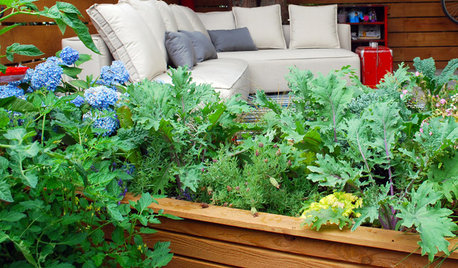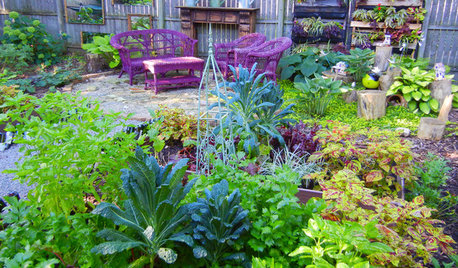Several of us have been talking lately about starting pepper, tomato, herb and other transplants.
I like to start my tomato transplants a bit early and then pot them up to progressively larger pots. This technique can give you larger, stronger, more vigorous plants with well-developed root systems.
Here's my favorite way to do it.
START THE SEEDS: Start seeds about 8 to 10 weeks before your anticipated spring transplanting date, which should be around the time of your average last frost date.
Start seeds in peat pellets or a sterile soil-less seed-starting mix in flats. Grow under fluorescent lights or in very bright, sunny windows so you will have strong, stocky plants that are not leggy.
REPOT. Once the plants have two sets of true leaves (do not count the cotyledons as true leaves), move the plants up to a small pot or small paper/plastic/foam cup with holes poked in the bottom for drainage. Set the small plant deeply in the soil (with the soil level ending just below the leaves). Water and put back under grow lights. Allow these plants to continue growing until there are now a total of ten true leaves....the original 4 plus 6 new ones.
REPOT AGAIN. At this point, it is time to repot again. First, prepare a set of larger paper, plastic or foam cups or small plastic flower pots or whatever you are going to transplant into. Then, remove the lower 4 (old) leaves. Set the plants into the soil in the new cups with the soil level right up to the bottom of the lowest of the six remaining leaves.
Do this again as soon as the plants have ten leaves. I usually do it between 2 and 4 times, depending on how long the weather stays cold and how long I have to keep the plants growing inside.
WHY? Why does this give you bigger, healthier transplants and why in the world do you remove the lower leaves?
Well, obviously, each time the plant goes into a new container, it has more room to send out more roots. That is only part of it though.
Every time you stress the plant by removing those lowest leaves, it responds by putting out new root growth....and you only get a small amount of new topgrowth. This is important because too much topgrowth gives large plants that can be hard to fit underneath the grow lights. Planting the stem deeply in the soil also encourages the plants to send out new roots from all buried parts of the stem. (This works for tomatoes and some other vegetable but not for all other veggies.)
HARDEN OFF THE PLANTS. As your transplanting date arrives, harden off the plants gradually by setting them outside in a protected area, like a covered porch where they get partial sun or under a shade cloth or even under a tree.....the limbs still provide some shade even if the tree isn't leafed out. On the first day, only give them a couple of hours of direct sun. Then, each day give them more and more sun. By the way, the plants need gradual exposure to stronger winds too. Going from "no wind" to a large amount of strong wind can cause enough windburn to kill the plants too.
TRANSPLANT: Unless you are willing to take heroic measures to protect early plantings from cold nights, do not transplant until you are pretty sure that your area will not experience another frost.
Transplant into well prepared soil. Carefully remove the plants from their containers, place them in holes dug into the ground, and pat the soil down firmly around them. The deeper you plant them, the better, so you can remove a couple of the lower leaves in order to bury more of the stem under the soil if you wish. Water well. Your plants have large, strong, healthy root systems so they should take off and grow quickly once they've adjusted to being transplanted.
IF YOU PLANT "EARLY": If you choose to plant earlier than the recommended date (last frost date or after), there are a few "tricks" you can employ to get the plants off to a good start.
First, you can warm up the soil for a couple of weeks prior to planting by covering it with thick black plastic held down by boards or rocks.
Secondly, you can give your plants a temporary wind break. One of my neighbors does this by cutting the bottom out of 5-gallon white buckets and placing the bucket firmly into the soil so it surrounds the tomato plant and gives it several weeks of wind protection. As a bonus, he has saved the lids that came with his white 5-gallon buckets and can snap them onto the top of the bucket at night if frost is predicted.
I provide my plants with wind protection for the first 2 to 4 weeks by wrapping the tomato cages with 6 mm plastic held to the cage with duct tape. Some people use bubble wrap in the same way, but I don't know if it is worth the extra expense or if it keeps them that much warmer than the 6mm plastic.
Not only does a windbreak shelter the tender foliage of young transplants from our often rowdy March and April winds, it also keeps the air around the plant slightly warmer (the greenhouse effect) which encourages good growth.
THIRD, you can use Wall-O-Waters or Cozy Coats to provide extra protection (down to 16 degrees in some cases) from the elements. They are a bit expensive and only work if you have flat, level ground. If your garden is on a slope (like mine) these types of plant protectors don't work as they tend to fall over and roll down hill.
FOURTH, mulch a little at planting time to be followed by more mulch later. At planting time, the ground is still relatively cool so you only add a little mulch....just enough to keep weeds from sprouting. This is because mulch that is too thick or deep will keep the ground cold longer and that will impede plant growth. Later, as the ground warms up, add more mulch to help conserve moisture and to keep the soil and roots cool.
A COUPLE OF MISCELLANEOUS TIPS FOR RAISING TOMATO TRANSPLANTS:
1. Play music for them. Some people swear that this encourages better growth and some scientific studies back up these claims. (I don't do this.)
2. Touch or stroke the plant stems. Every day, take a moment or two to stand there by the plants and lightly run your index finger up and down the plant stem. This stimulus is supposed to cause increased growth.
An alternate method if you have a lot of seedlings growing closely together is to gently run your hands over the top of the plants just barely making contact with the topmost foliage. Do this for a minute or two once or twice a day to stimulate growth.
3. Give them great air circulation. Set up a small oscillating fan so it blows a GENTLE breeze towards the plants. Research shows that the breeze stimulates growth and helps the plants to have stronger, stockier stems. As a bonus, it improves air circulation and that helps cut down on foliar disease problems.
4. Water carefully and sparingly, and from the bottom if possible. Too much water keeps the soil too wet and can cause all sorts of problems including damping off (sudden death of seedlings). Plants should be moist but can be allowed to get almost completely dry before you water them again. At all costs, avoid keeping them sopping wet.
5. Don't feed them. Young plants, in general, do not need to be fed. The exception is that, if you are keeping them in peat pellets for a prolonged period of time, they may need to be fed once or twice with a water-soluable fertilizer. In that case, though, it is best to dilute the fertilizer so that it is very weak. Strong fertilizer on young, tender roots can cause damage.
6. Give them periods of light AND darkness. Some people leave their plants' growlights on 24 hours a day. However, research shows that most plants benefit from at least 8 hours of darkness.
OTHER VEGGIE TRANSPLANTS:
PEPPERS: I raise my pepper transplants the same as tomatoes, except they DON'T go through the process of being potted up into larger pots and having their lower leaves removed. Also, pepper plants DO NOT benefit from being planted deeply and also DO NOT form roots along the buried parts of the stems. Also, I don't move them outside or plant them as early since they like significantly warmer soil and air temps.
RAISING OTHER VEGGIE SEEDLINGS: You can raise many other plants from seed indoors and then transplant them into the ground. These are the ones, in addition to peppers and tomatoes, that are most often raised to transplant size: broccoli, brussels sprouts, cabbage, cauliflower, chinese cabbage, lettuce and other greens (can be grown from transplant or by direct seeding in the garden), peas, cantaloupe and other melons, squash, pumpkins, and okra.
The ones most commonly direct seeded into the ground include green beans and other beans, southern peas, carrots, lettuce and other greens including spinach, corn, radishes, turnips and rutabagas.
Sometimes, when cold, wet weather delays outdoor planting, I have started peas, beans and corn in peat pellets and have transplanted them while they were still very small plants.
Some plants have to be started from sets or tubers. These include Irish potatoes, horseradish, most onions, garlic and leeks, and rhubarb. (You can start rhubarb from seed but are unlikely to get a harvest the first year.) Sweet potatoes are started from 'slips' which are basically sprouts that grow off of a mother potato, are pulled off and bundled up and then sold. You can grow your own slips inside and then remove them and plant them inside.
If you have a really hard time sprouting carrot seeds (a more common problem than you'd think), you can start them indoors in cardboard-paper tubes and then transplant them, tube and all, into the garden.
Most warm-season veggies can be grown from seed to transplant size in only 3 to 5 weeks. If you have to hold these transplants inside too long, it can stunt their growth.
Any seed that is large enough to handle easily (like pepper or tomato seeds, melon seeds, etc.) will sprout more quickly if pre-soaked in water or half-strength compost tea or liquid seaweed. Soak them for only 4 to 8 hours. If you want to presoak legumes, only soak them for a couple of hours.
All transplants grown indoors need proper lighting and to be hardened off before transplantation.
That's all I can think of, and I'm sure there's a lot I forgot, but it is a start.
Dawn













oakleif
Okiedawn OK Zone 7Original Author
Related Discussions
Vegetable seedlings, transplanting, and feeding
Q
New to Vegetable Gardening - Tomato Questions
Q
Big healthy plants for great tasting tomatoes?
Q
Something went wrong with tomato transplants
Q
backyardmomma
Okiedawn OK Zone 7Original Author
ilene_in_neok
barton
Okiedawn OK Zone 7Original Author
ilene_in_neok
Okiedawn OK Zone 7Original Author
ilene_in_neok